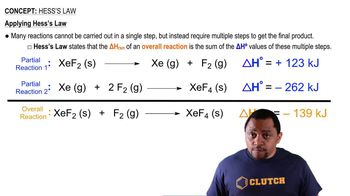From the following data for three prospective fuels, calculate which could provide the most energy per unit mass and per unit volume:
Three hydrocarbons that contain four carbons are listed here, along with their standard enthalpies of formation: Hydrocarbon Formula ΔHfº (kJ/mol) Butane C4H10(g) -125 1-Butene C4H8(g) -1 1-Butyne C4H6(g) 165. (a) For Butane, calculate the molar enthalpy of combustion to CO2(g) and H2O(l). (kJ/mol) (b) For 1-Butene, calculate the molar enthalpy of combustion to CO2(g) and H2O(l). (kJ/mol) (c) For 1-Butyne, calculate the molar enthalpy of combustion to CO2(g) and H2O(l).
 Verified step by step guidance
Verified step by step guidanceKey Concepts
Enthalpy of Formation (ΔHfº)

Combustion Reaction

Hess's Law

A 201-lb man decides to add to his exercise routine by walking up three flights of stairs (45 ft) 20 times per day. Hefigures that theworkrequired to increasehis potential energy in this way will permit him to eat an extra order of French fries, at 245 Cal, without adding to his weight. Is he correct in this assumption?
Sucrose (C12H22O11) is produced by plants as follows: 12 CO2(g) + 11 H2O(l) → C12H22O11 + 12 O2(g) H = 5645 kJ About 4.8 g of sucrose is produced per day per square meter of the earth's surface. The energy for this endothermic reaction is supplied by the sunlight. About 0.1 % of the sunlight that reaches the earth is used to produce sucrose. Calculate the total energy the sun supplies for each square meter of surface area. Give your answer in kilowatts per square meter 1kW/m2 where 1W = 1 J/s2.
